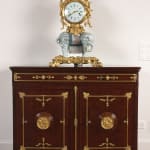Alexandre-Louis Bellangé
Literature
Literature: Léon de Groër, “Les Arts Décoratifs de 1790 à 1850”, 1985, p. 113, pl. 200 illustrating a similar gilt bronze mounted commode by Louis-Alexandre- Bellangé in the Musée des Art Décoratifs, Paris.
Sylvain Cordier, “The Bellangé Album and New Discoveries in French Nineteenth-Century Decorative Arts”, in “The Metropolitan Museum Journal”, vol. 47, 2012, p. 123, pl. 7, illustrating a slightly more ornate commode of 1834 by Louis-Alexandre Bellangé of similar overall form, which was sold in 1975 (present location unknown) and p. 143, folio 27, illustrating a pen and wash design attributed to Louis-Alexandre Bellangé for a very similar commode, which as here has a long frieze drawer with comparable mounts, above two doors, each with a similar framed border but centred by ewers.
A very fine Louis Philippe gilt bronze mounted mahogany commode by Louis-Alexandre Bellangé, stamped on the commode itself and on its lock Bellangé Ebéniste du Roi, the rectangular moulded top above a frieze drawer mounted with a central rosette and flanking foliate handles, each issuing from scrolled sprays within a banded frame, the frieze drawer above two doors centred by an upright fluted band with an anthemion tip, each door decorated with a central circular cast medallion portraying a winged putto taming a griffin or other mythical monster and set within a framed border, with a scrolled anthemion to the corners and foliate scrolls to the sides, the doors opening to reveal three shelves within, supported on a plain stepped base
Paris, date circa 1835-40
Height 96 cm, width 120 cm, depth 56.5 cm
Typifying the bold forms of the Louis Philippe period, this handsome commode was made by Louis-Alexandre Bellangé (1797-1861), Ebéniste du Roi, who was one of the leading Parisian furniture makers during the reigns of Charles X and Louis Philippe. In addition to the design for a commode, almost certainly executed by Louis-Alexandre, which appears in the Bellangé album, now in the Metropolitan Museum, one can also cite a comparable commode in the Musée des Art Décoratifs, Paris. As here, the latter is of a robust overall form, comprising a frieze drawer over two doors centred by an upright gilt bronze band and with both doors featuring a bold cast panel within a rectangular frame.
Born on 12th August 1797, Louis-Alexandre’s mother was Marie-Anne-Agnès, daughter of the menuisier Alexandre-Nicolas Quenet while his father was the renowned ébéniste Pierre-Antoine Bellangé (1757-1827), who with Jacob-Desmalter and Pierre-Benoit Marcion, was one of the most important suppliers of furniture to Emperor Napoleon Bonaparte and his immediate circle. Among his father’s more important commissions was an order in 1812 to furnish the salon d’exercise in the apartment of Napoleon’s son, the King of Rome, at the Palais des Tuileries as well as an order in 1817 from the American President James Monroe to supply a complete suite of furniture for the newly rebuilt White House in Washington. Despite such prestigious commissions, Pierre-Antoine Bellangé often faced financial difficulties.
Louis-Alexandre Bellangé began working with his father in 1820, with an agreement that he would receive 3.5 % share of the profits. In January 1825, he succeeded his father as head of the family workshop along with it the position of fournisseur breveté, which in 1832 was retitled ébéniste du roi during Louis Philippe’s reign. Like his father, Louis-Alexandre went on to create exceeding fine and high quality furniture which he supplied to many of the royal palaces as well as museums.
Among important commissions, Louis-Alexandre delivered several sets of furniture for the palaces and châteaux of the Tuileries, Trianon, Saint-Cloud, Fontainebleau, and Pau; in addition, he was placed in charge of supplying the museums that were administered by the royal household at the time. For instance, he produced a series of benches for the Musée des Antiques at the Louvre, as well as many benches, stools, and pieces of furniture in a neo-Louis XIV style for the newly opened museum of Versailles, which was inaugurated in 1837. Louis-Alexandre was also a regular and successful exhibitor at the Expositions des Produits de l’industrie Française, where he showed his work in 1827, 1834, and 1839 and on each occasion was awarded a silver medal.
Despite his success, Louis-Alexandre often experienced the same financial problems that his father had encountered. These problems continued throughout his career, to the extent that the workshop even went bankrupt in September 1831 though it managed to reopen the following year. However, the situation worsened at the beginning of 1840, forcing Bellangé to retire on the eve of 1844.
Deciding to leave France, he and his son then went to Mexico, where one of his younger brothers, Pierre-Alexandre, a chemist, enjoyed a successful career in the silver-mining business. However, this venture only lasted a few years when both he and his son returned to France, sometime before 1851. They lived in Maisons-sur Seine for a short period before moving back to Paris, where Louis-Alexandre died on 7th June 1861.



